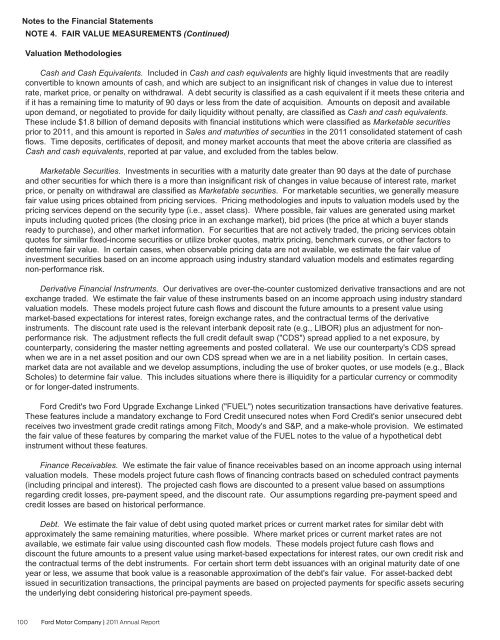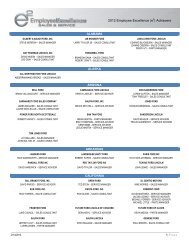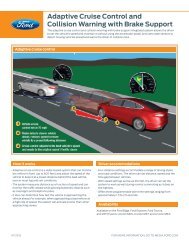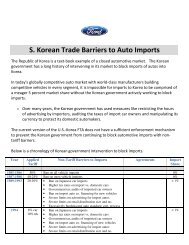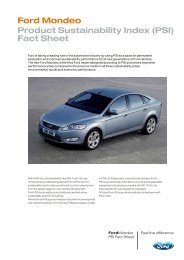Annual Report 2011 - Ford Motor Company
Annual Report 2011 - Ford Motor Company
Annual Report 2011 - Ford Motor Company
You also want an ePaper? Increase the reach of your titles
YUMPU automatically turns print PDFs into web optimized ePapers that Google loves.
Notes to the Financial Statements<br />
NOTE 4. FAIR VALUE MEASUREMENTS (Continued)<br />
Valuation Methodologies<br />
Cash and Cash Equivalents. Included in Cash and cash equivalents are highly liquid investments that are readily<br />
convertible to known amounts of cash, and which are subject to an insignificant risk of changes in value due to interest<br />
rate, market price, or penalty on withdrawal. A debt security is classified as a cash equivalent if it meets these criteria and<br />
if it has a remaining time to maturity of 90 days or less from the date of acquisition. Amounts on deposit and available<br />
upon demand, or negotiated to provide for daily liquidity without penalty, are classified as Cash and cash equivalents.<br />
These include $1.8 billion of demand deposits with financial institutions which were classified as Marketable securities<br />
prior to <strong>2011</strong>, and this amount is reported in Sales and maturities of securities in the <strong>2011</strong> consolidated statement of cash<br />
flows. Time deposits, certificates of deposit, and money market accounts that meet the above criteria are classified as<br />
Cash and cash equivalents, reported at par value, and excluded from the tables below.<br />
Marketable Securities. Investments in securities with a maturity date greater than 90 days at the date of purchase<br />
and other securities for which there is a more than insignificant risk of changes in value because of interest rate, market<br />
price, or penalty on withdrawal are classified as Marketable securities. For marketable securities, we generally measure<br />
fair value using prices obtained from pricing services. Pricing methodologies and inputs to valuation models used by the<br />
pricing services depend on the security type (i.e., asset class). Where possible, fair values are generated using market<br />
inputs including quoted prices (the closing price in an exchange market), bid prices (the price at which a buyer stands<br />
ready to purchase), and other market information. For securities that are not actively traded, the pricing services obtain<br />
quotes for similar fixed-income securities or utilize broker quotes, matrix pricing, benchmark curves, or other factors to<br />
determine fair value. In certain cases, when observable pricing data are not available, we estimate the fair value of<br />
investment securities based on an income approach using industry standard valuation models and estimates regarding<br />
non-performance risk.<br />
Derivative Financial Instruments. Our derivatives are over-the-counter customized derivative transactions and are not<br />
exchange traded. We estimate the fair value of these instruments based on an income approach using industry standard<br />
valuation models. These models project future cash flows and discount the future amounts to a present value using<br />
market-based expectations for interest rates, foreign exchange rates, and the contractual terms of the derivative<br />
instruments. The discount rate used is the relevant interbank deposit rate (e.g., LIBOR) plus an adjustment for nonperformance<br />
risk. The adjustment reflects the full credit default swap ("CDS") spread applied to a net exposure, by<br />
counterparty, considering the master netting agreements and posted collateral. We use our counterparty's CDS spread<br />
when we are in a net asset position and our own CDS spread when we are in a net liability position. In certain cases,<br />
market data are not available and we develop assumptions, including the use of broker quotes, or use models (e.g., Black<br />
Scholes) to determine fair value. This includes situations where there is illiquidity for a particular currency or commodity<br />
or for longer-dated instruments.<br />
<strong>Ford</strong> Credit's two <strong>Ford</strong> Upgrade Exchange Linked ("FUEL") notes securitization transactions have derivative features.<br />
These features include a mandatory exchange to <strong>Ford</strong> Credit unsecured notes when <strong>Ford</strong> Credit's senior unsecured debt<br />
receives two investment grade credit ratings among Fitch, Moody's and S&P, and a make-whole provision. We estimated<br />
the fair value of these features by comparing the market value of the FUEL notes to the value of a hypothetical debt<br />
instrument without these features.<br />
Finance Receivables. We estimate the fair value of finance receivables based on an income approach using internal<br />
valuation models. These models project future cash flows of financing contracts based on scheduled contract payments<br />
(including principal and interest). The projected cash flows are discounted to a present value based on assumptions<br />
regarding credit losses, pre-payment speed, and the discount rate. Our assumptions regarding pre-payment speed and<br />
credit losses are based on historical performance.<br />
Debt. We estimate the fair value of debt using quoted market prices or current market rates for similar debt with<br />
approximately the same remaining maturities, where possible. Where market prices or current market rates are not<br />
available, we estimate fair value using discounted cash flow models. These models project future cash flows and<br />
discount the future amounts to a present value using market-based expectations for interest rates, our own credit risk and<br />
the contractual terms of the debt instruments. For certain short term debt issuances with an original maturity date of one<br />
year or less, we assume that book value is a reasonable approximation of the debt's fair value. For asset-backed debt<br />
issued in securitization transactions, the principal payments are based on projected payments for specific assets securing<br />
the underlying debt considering historical pre-payment speeds.<br />
100 <strong>Ford</strong> <strong>Motor</strong> <strong>Company</strong> | <strong>2011</strong> <strong>Annual</strong> <strong>Report</strong>


